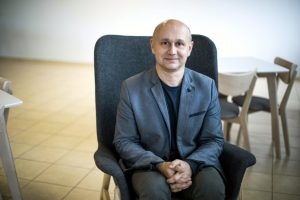Nov 28 2018
A research team at Kaunas University of Technology (KTU) Lithuania has identified a new technique in which industrial waste products can be used for creating gypsum-binding material with increased strength. The researchers combined zeolite, a waste product from oil refining industry; phosphogypsum, a fertilizing production waste; and an activator to cast gypsum stone, whose strength was double than usual.
 KTU researcher Aras Kantautas, co-author of the invention. (Image credit: Kaunas University of Technology)
KTU researcher Aras Kantautas, co-author of the invention. (Image credit: Kaunas University of Technology)
Approximately 5 tons of phosphogypsum is produced for each ton of phosphoric acid production, and phosphogypsum generation across the globe is estimated to be about 100–280 MT per annum. Universally, 15% of phosphogypsum production is recycled as soil stabilization amendments, agricultural fertilizers, or building materials, and as setting controller in the production of Portland cement. The remaining phosphogypsum is kept near factories, which not only leads to serious environmental contamination but also occupies massive land areas. In Lithuania, for example, the phosphate industry firm Lifosa generates almost 500,000 tons of phosphoric acid and as much as four to five times of the phosphogypsum, which is sent to the waste piles.
We have had enquiries from industry, who were interested in managing their waste products, and this was the primarily impulse for our research. All the materials used in our invention are waste products from different industries. After combining zeolite, which is coming from an oil refining company, and phosphogypsum from fertilizer producer we added a certain activator, which changed the micro structure and significantly increased the strength of the final product – plaster stone.
Aras Kantautas, Researcher and Study Co-Author, Faculty of Chemical Technology, Kaunas University of Technology.
Danutė Vaičiukynienė, co-author of the invention and researcher at KTU Faculty of Civil Engineering and Architecture, stated that the amount of research on creating plaster from zeolite and phosphogypsum is significant. Yet, the exclusivity of KTU’s invention lies in integrating three waste materials: “By adding supplements we increased the compressive strength of phosphogypsum from 11 MPa to 22 MPa. Our material has much better mechanical and constructive properties, which is very important having in mind that plaster is usually used in building industry and strength is its most important quality.”
KTU researchers used zeolite—an extremely strong sorbent—for cleaning phosphogypsum, which when acquired as a waste product is contaminated with phosphoric acid. At the time of the experiments, the optimal quantity of all the additives to the mixture was established by the researchers to obtain the best qualities of the end product: for acid sorption, the optimal proportion of zeolite is 5%; 5% of activator in the mixture brought its pH to 6.95 and 10% of activator brought its pH to 6.07. When an optimal proportion of zeolite sorbent was used, there was an increase in the compressive strength of dry samples, and the pH of the end product reached close to neutral.
The analogical research focusing on production of plaster from phosphogypsum usually involves using high temperatures or expensive binding materials. Whereas for our invention we use only waste materials from different industries, which can not only be acquired for symbolic price, but also are becoming a useful material for building and other industries, wherever plaster is used. Our gypsum stone is stronger than standard and its production is not only simpler and more efficient, but is also adding to the zero-waste industry concept.
Dalia Nizevičienė, Researcher and Study Co-Author, Kaunas University of Technology.
A patent of KTU’s invention has already been applied to the State Patent Bureau of Lithuania. As soon as the patent is received, the KTU’s researchers will look into collaboration with business organizations so as to commercialize their invention. Technology transfer is enabled by KTU National Innovation and Entrepreneurship Centre—one-stop shop for knowledge intensive business to contact research.